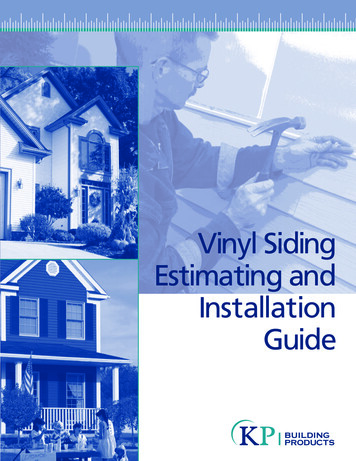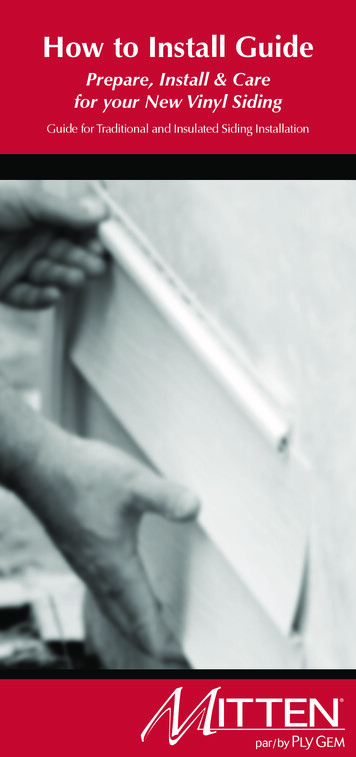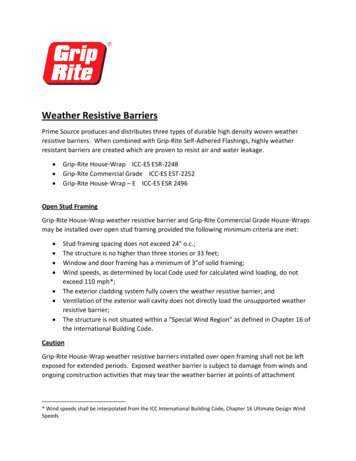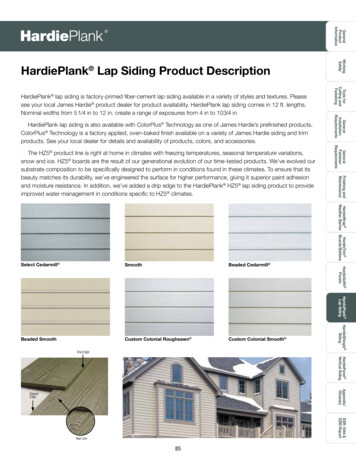
Transcription
Vinyl SidingEstimating andInstallationGuide
Understanding the BasicsContractors and homeowners alike have depended on the low maintenance sidings from KPBuilding Products for the best product designs and engineering that will give them a professionalinstallation every time. Whether you do it yourself, or have a contractor do it for you, your home isgoing to go through an amazing transformation and you’re going to love it.At KP Building Products there’s a complete system to cover your entire home in low-maintenancevinyl around doors and windows. Plain and fancy corner posts. Soffit designed to fit all youroverhangs and porches as well as the fascia and accessories to complete the job. With KPBuilding Products, you can enter into the job with confidence knowing that everything you needwill be there from installation instructions and tips to all the special trim pieces and accessories.Table of contentThe installation manual was designed to walk you through the job, so follow the steps as theyare laid out. It is best to read ahead as you work, so you will have a better understanding of thedirections and the order in which to proceed. This is the best path to that completed job that willhave the neighbors and friends asking you how you did it. Good luck.General estimating tips.3Glossary .6Fasteners .7Accessories .8Summary sheet .9General installation tips .10Installing accessories .13Horizontal siding installation .16Adirondack vinyl log siding installation .20Horizontal insulated siding installation .22Vertical siding installation .24Installing soffits and fascia .26TrimFX installation .28Vinyl skirting installation instructions .31Cleaning instructions .322
General estimating tipsEstimating for sidingMost homes’ surface areas are made up of a series of rectangles or triangles.When estimating vinyl siding, estimate each rectangular or triangular section separately and add the totalstogether. Rather than trying to multiply feet and inches together, simply round to the next highest three-inch(or .25’) increment and use the decimal equivalent.For example:10’ - 1” would become 10’ - 3” or 10.25’10’ - 5” would become 10’ - 6” or 10.50’10’ - 7” would become 10’ - 9” or 10.75’10’ - 10” would become 11’Multiplication then becomes simple: 10.25’ x 10.75’ 110.19 sq. ft.When all the individual sections are added together, the total is divided by 100 for the total number of squares.This will be rounded up to the next whole square.Example houseA house is 40’ x 30’ x 9’ feet high at the eaves.Front is 40’ x 9’ or . 360 sq. ft.Back is the same or. 360 sq. ft.Right end is 30’ x 9’ to the eave line or . 270 sq. ft.Left end is the same or. 270 sq. ft.Total. 1260 sq. ft.Calculating gable areaWidth of the house is 30’ with a 12” or 1’ overhang, front and rear. This totals a gable width of 32’. The roofpitch of this house is 5 in 12, which means for every foot of run, the gable rises 5”. The run is always half ofthe total width, in this case 32’, so the run is half of that, or 16’.To convert the 5” to feet, divide it by 12. (5 divided by 12 .42 ft.)To figure the height of the gable, multiply the run of 16’ by the rise per foot or .42’. 16’ x .42’ 6.72’.This is the gable’s height at the center.Multiply the width by the height: 32’ x 6.72’ 215 sq. ft.Multiply this by .75 to allow for waste in cutting along the rake. 215 sq. ft. x .75 161.2 sq. ft. in one gable.You have two gables, so multiply 161.2 x 2 which 322.4 sq. ft. of total gable area.Add this to the 1260 sq. ft. figured for the walls, above.1260 sq. ft. 322.4 sq. ft. 1582.4 square feet of total siding.1582.4 sq. ft. divided by 100 sq. ft (1 square) 15.82 squares. Round this up to 16 squares.You notice that we did not deduct for openings and always rounded up, so there is no need to add back to theestimate for cutting waste.16 squares will do this job.3
General estimating tipsEstimating for soffitSoffit material will be used on the front and rear eaves, the gable overhangs, the dormer overhangs and any porch ceilings.Calculating the eavesFor the front and rear eaves, add the total length of each section and multiply by the width. The width is a straight-line distance fromthe wall to the tails of the rafters. This would also be done on the ends of the home on a hip roof.Our sample home in GENERAL ESTIMATING TIPS was 40’ long with a 12” overhang on each of its two gables. Total length of thehome then, would be 42’. If the overhang is 12” on both the front and the rear eave, then the square footage of soffit needed is42’ x 1’ 42 sq. ft.The back is a duplicate of the front so the total is 42 sq. ft. 42 sq. ft. 84 sq. ft.These low eaves will require vented soffit for attic ventilation, so we will order 1 square of vented soffit for this job.Use the same process of rounding up to the next highest 3” increment as described in general estimating tips . Do the samefor any dormer eaves.Calculating the gable overhangsFor the gable or dormer overhangs (rakes), you must determine the length of each section. These will be angled and the lengthwill be dependent upon the pitch of the roof. The easiest way is to scale them off of the building plan. If you don’t have access tothe plan, here is the process.Let’s use the same home we used in general estimating tips. The width of this home was 30’ with a 12” overhang, front and rear,making the gable width 32’. The run is half this width or 16’.The height as we calculated earlier was 6.72’. To figure the diagonal, which is the measurement we want, we do the following:Multiply 16’ x 16’ and record the answer. (16’ x 16’ 256’)Multiply 6.72’ x 6.72’ and record the answer. (6.72’ x 6.72’ 45.16’)Add the two answers. (256’ 45.16’ 301.16’)Put this number into your calculator and hit the square root button.The answer is 17.35’.This is the length of one side of the gable or soffit overhang.As there are always two pitched sides to a gable or dormer, multiply the result by 2.17.35’ x 2 34.7 linear feet. Round it up to 35 linear feet.Multiply this by the width of the overhang. Let’s assume 12” or 1 ft.35 linear feet x 1 foot 35 square feet. Enter this into your worksheet.The other gable is the same, so enter 35 square feet for it into the worksheet.Total soffit material required for both gables is 35 35 70 sq. ft. This does not have to be vented, so solid soffit isordered for this section. We will order 1 square of solid (non-vented) soffit for this portion. Continue this same processfor all gables and pitched dormers.SoffitsMeasure the width of the eave to be covered. Measure the length of the eave.Do this for each eave, including the rakes of the gables and dormer eaves.Eave 1: (width) x (length) sq. ft. vented soffitEave 2: (width) x (length) sq. ft. vented soffitEave 3: (width) x (length) sq. ft. vented soffitEave 4: (width) x (length) sq. ft. vented soffitEave 5: (width) x (length) sq. ft. solid soffitEave 6: (width) x (length) sq. ft. solid soffitEave 7: (width) x (length) sq. ft. solid soffitEave 8: (width) x (length) sq. ft. solid soffitTotal Vented Soffit: sq. ft.Total Non-Vented (solid) Soffit: sq. ft.4
General estimating tipsWall surfacesMeasure the height (excluding gables). Measure the width.Do not deduct for doors and windows. Do this for each wall section,including any surface to receive siding.Wall 1: (h x w) sq. ft.Wall 2: (h x w) sq. ft.Wall 3: (h x w) sq. ft.Wall 4: (h x w) sq. ft.Wall 5: (h x w) sq. ft.Wall 6: (h x w) sq. ft.Wall 7: (h x w) sq. ft.Wall 8: (h x w) sq. ft.Wall 9: (h x w) sq. ft.Wall 10: (h x w) sq. ft.Total: sq. ft.Gable surfacesMeasure the height at the center. Measure the width.Do not deduct for doors and windows. Do this for each gable to receivesiding. Multiply the results by .75 (75%).Gable 1: (width) x (height) x .75 sq. ft.Gable 2: (width) x (height) x .75 sq. ft.Gable 3: (width) x (height) x .75 sq. ft.Gable 4: (width) x (height) x .75 sq. ft.Gable 5: (width) x (height) x .75 sq. ft.Gable 6: (width) x (height) x .75 sq. ft.Total: sq. ft.Dormer surfacesMeasure the height of the dormer. Measure the width.Multiply the results by .75 (75%). Multiply the results by 2 to take off bothsides of each dormer. Do this for each dormer.Dormer 1: (h x w) x .75 (x 2) sq. ft.Dormer 2: (h x w) x .75 (x 2) sq. ft.Dormer 3: (h x w) x .75 (x 2) sq. ft.Dormer 4: (h x w) x .75 (x 2) sq. ft.Dormer 5: (h x w) x .75 (x 2) sq. ft.Dormer 6: (h x w) x .75 (x 2) sq. ft.Total: sq. ft.Porch ceilingsMultiply the width of each rectangular area by the length; add totals ofeach rectangular area.(width) x (length) of area 1 sq. ft.(width) x (length) of area 2 sq. ft.Total Non-Vented (solid) Soffit: sq. ft.5
Terms to knowBackerboard — a flat material used on the face of the house, applied between the studs and the siding(or over existing wall surface), to provide an even surface for installing vinyl siding.Buttlock — the bottom edge of a siding or soffit panel, or accessory piece, opposite the nailing slots, which locksonto to the preceding panel.Channel — the area of the accessory trim or corner post where siding or soffit panels are inserted. Channels alsorefer to the trim itself, and are named for the letters of the alphabet they resemble (e.g., J-channel, F-channel, etc.).Course — a row of panels, one panel wide, running the length of the house from one side to the other, or, in the caseof vertical siding, from top to bottom.H-channel — a siding accessory that joins two soffit panels, or used as transition between two siding sections.Face — refers to the side of a siding or soffit panel that is showing once the panel has been installed.Face-nailing—the action of fastening directly onto the “face” side of a panel (instead of using the nail hem slot).This practice is generally not used in siding installation.Fascia — the trim covering the ends of roof rafters and gables.Fascia board — a board attached to the ends of the rafters and gables between the roofing material and the soffitoverhang. Fascia cap is the covering around that board.Flashing — a thin, flat material, usually aluminum, positioned under or behind J-channels, corner posts, windows,etc., to keep draining water from penetrating the home. Flashing is also used around the windows and doors.Furring/Furring strip — usually a 1” x 2” wood strip used to even a surface in preparation for installing vinyl siding.To “fur” a surface means to apply these strips.Lap — to overlap the ends of two siding panels or accessory pieces to allow for expansion and contraction.Tab — the raised “ears” on a siding panel, created by a snap lock punch, which can be used to lock a siding panelinto place when the nailing hem has been removed.Miter — to make a diagonal cut, beveled to a specific angle (usually 45 ). Sometimes miter cuts are made into anoverlapping siding or soffit panel surface, to provide a neater appearance.Nailing hem — the section of siding or accessories where the nailing slots are located.Plumb — a position or measurement that is truly and exactly vertical, 90 from a level surface.Rake (roof) — the inclined, usually projecting edge of a sloping roof. Rake (wall)—the boardor molding placed along the sloping sides of a gable to cover the ends of the siding.Scoring — running a utility knife blade, a sharpened awl, scoring tool, or other sharpimplement across a soffit or siding panel face without cutting all the way through thepanel. This weakens the vinyl surface in a specific area and allows the panel to be bentand broken off cleanly.Sealant — any of a variety of compounds used to fill or seal joints in wood, metal,masonry, vinyl, and other materials.Shim — a building material used to even a surface prior to installing vinyl siding.Soffit — material used to enclose the horizontal underside of an eave, cornice, oroverhang. Soffit is designed to be installed lengthwise from wall to fascia.Starter trim — an accessory applied directly to the surface of the building and used tosecure the first course of siding to the home.Square — a square represents an area of 10’ by 10’ (100 sq. ft.) and is generallythe term used in the industry v when referring to the quantity of siding. Vinyl siding ismeasured in squares, i.e.: this house requires 20 squares of siding.Underlayment/Underlayment board — weather resistant material placed under vinylsiding panels.Undersill trim — a piece of trim used any time the top lock has been removed from thesiding, to secure a siding panel.Siding descriptionWeep holes — openings cut into siding or accessories to allow for water runoff.Window/door drip cap — an accessory installed with vertical siding to ensure that waterdrips away from panels and does not infiltrate them.Outside and inside corner posts — Corner posts are used to provide a finished edge at an inside or outsidecorner. The siding from adjoining walls fits neatly into the inside or outside corner post channels. Appropriatewidths of channel openings are available to accommodate various configurations of siding.6
FastenersFastener choicesUse aluminum, galvanized steel, or other corrosion-resistant nails, staples, or screws when installing vinyl siding.Aluminum trim pieces require aluminum or stainless steel fasteners. All fasteners must be able to penetrate not less than3/4” into framing or furring. Review your local building codes for variations that may apply to specific geographic areasNailsNail heads should be 5/16” minimum in diameter. Shank should be 1/8” in diameter.Screw fastenersScrew fasteners can be used if the screws do not restrict the normal expansion and contraction movement of the vinylsiding panel on the wall. Screws must be centered in the slot with a minimum 1/32” space between the screw head andthe vinyl. Screws must be able to penetrate not less than 3/4” into framing or furring and should be: Size #8, truss head or pan head. Corrosion-resistant, self-tapping sheet metal type.StaplesIf staples are being used instead of nails or screws, they must: Not be less than 16-gauge semi-flattened to an elliptical cross-section. Penetrate not less than 3/4” into framing or furring. Be wide enough in the crown to allow free movement of the siding(1/32” away from the nailing hem).Use of staples when installing siding7
AccessoriesStarter trim 10’Window/door drip cap 10’Undersill trim 12’ 6”Dual undersill trim 12’ 6”F-channel 12’ 6’’J-channel 12’ 6’’Outside corner post 10’Inside corner post 10’Vertical base flashing 10’Vinyl fascia 12’ 6”H-channel 12’ 6”3-1/2” lineal trim 12’5” lineal trim 12’Lineal starter trim 12’Quarter round cormer starter 12’6” Fluted corner 10’6” Traditional corner 10’8How to determine the numberof pieces required:Measure structure perimeter.Convert to decimal, divide by 10 and round up.# of pieces needed:Measure tops of all window and door cap openings.Convert to decimal, divide by 10 and round up.# of pieces needed:Measure bottom of all areas where siding must be cut horizontally(at the top of wall and under all door and window openings).Convert to decimal, divide by 12.5 and round up.# of pieces needed:Measure bottom of all areas where siding must be cut horizontally(at the top of wall and under all door and window openings).Convert to decimal, divide by 12.5 and round up.# of pieces needed:Measure span where all soffits return to wall.Convert to decimal, divide by 12.5, and round up.# of pieces needed:For open eaves, multiply the pieces calculated above by 2:Measure around all openings (doors, windows and gable ends).Convert to decimal, divide by 12.5 and round up.# of pieces needed:Measure length on all outside corners.Convert to decimal, divide by 10 and round up.# of pieces needed:Measure length of all inside corners.Convert to decimal, divide by 10 and round up.# of pieces needed:Measure bottom of sidewall where vertical siding is being installed.Convert to decimal, divide total by 10 and round up.# of pieces needed:Measure span of all roof lines to determine total footage of fascia required.Convert to decimal, divide by 12.5 and round up.# of pieces needed:Measure span from inside wall to end of roof line (typically 45 ).Convert to decimal, divide by 12.5 and round up.# of pieces needed:Measure around all openings (doors, windows and corners) wherethe lineal is to be installed. Convert to decimal, divide by 12 and round up# of pieces needed:Measure around all openings (doors, windows and corners) wherethe lineal is to be installed. Convert to decimal, divide by 12 and round up.# of pieces needed:Equal quantity of Lineal starter is requiredfor the amount of lineal ordered.# of pieces needed:Measure all quarter round corner starter where the corner bead isto be installed. Convert to decimal, divide by 12 and round up# of pieces needed:Measure all corners where the piece is to be installed.Convert to decimal, divide by 10 and round up .# of pieces needed:Measure all corners where the piece is to be installed.Convert to decimal, divide by 10 and round up.# of pieces needed:
Summary sheetSidingTotal from horizontal wall areaTotal from gable areaTotal from dormer areaTotal sidingsq. ft.sq. ft.sq. ft.sq. ft.Type of sidingNorman RockwellCedar CreekDakotaNorthern Star RusticNorthern StarMaximMaxim I/S D4.5DLD4.5DLD5D5D5DLD5DLT3Color:TrimsStarter trim 10’Window/door drip cap 10’Undersill trim 12’ 6”Dual undersill trim 12’ 6”F-channel 12’ 6’’J-channel 12’ 6’’Outside corner post 10’Inside corner post 10’Vertical base flashing 10’Vinyl fascia 12’ 6”H-channel 12’ 6”Adirondack 1 1/4” J-channel 12’6”Adirondack 4” Outside Corner post 1 1/4” 12’Color: : # of pieces needed:Color: : # of pieces needed:Color: : # of pieces needed:Color: : # of pieces needed:Color: : # of pieces needed:Color: : # of pieces needed:Color: : # of pieces needed:Color: : # of pieces needed:Color: : # of pieces needed:Color: : # of pieces needed:Color: : # of pieces needed:Color: : # of pieces needed:Color: : # of pieces needed:TrimFX 5” Lineal trim 12’3 1/2” Lineal trim 12’Lineal Starter trim 12’Quarter round corner starter 12’6” Fluted corner 10’6” Traditional corner 10’Color: :Color: :Color: :Color: :Color: :Color: :# of pieces needed:# of pieces needed:# of pieces needed:# of pieces needed:# of pieces needed:# of pieces needed:SoffitTotal from soffitsq. ft.Total from porch ceilingsq. ft.Total soffit:Ventedsq. ft.Non-Ventedsq. ft.Color:WhiteMatch SidingAdd a factor of 10 percent to all material estimates to allow for waste.9
General installation tipsBefore you beginThese instructions have been specially written to provide you with a simple, straightforward, step-by-stepguide for installing your KP Building Products vinyl siding. In fact, the best installation advice we cangive is that you read through these instructions carefully before beginning your project. Because properpreparation is the key to a smooth installation job.Remember to always exercise caution when on a construction site.Tool checklist:Tool Checklist: work table tape measure hammer utility knife chalk line square tin snips level safety glasses* ladders and/or scaffolding radial saw with a reversed fine-tooth blade*NOTE: Protective eyewear should be worn when cutting, sawing, or nailing.Some specialized tools include: snap-lock punch nail-slot punchsoffit j-trim cutterdual undersill trim siding removal toolsidingundersill triminsidecorner postoutsidecorner postfasciawindow door capf-channelh-channelstarter lldualf-channelbase door drip cap trimundersill trimHorizontal sidingVertical sidingSoffitFascia10 ——— —— — — —— —j-channel —outsideinside vertical base h-channelcorner post corner post flashing —— ——— ———— —vinylfascia———
General installation tipsImportant installation tipsBefore getting started, it is important to review several rules of thumb for vinyl siding application.The following rules, which come up throughout this guide, are critical for proper vinyl siding installation:The following are absolute “must-do’s” for every siding installation:1. Installed panels must move freely from side to side. Don’t nail too tightly.Always allow a minimum of 1/32” space between the back of the head andthe nailing hem. Space fasteners 12” - 16” apart on center.2. When installing a siding panel, push up from the bottom until the lock is fullyengaged with the piece below it. Without stretching the panel, reach up andfasten it into place.3. When finishing the top of the wall perforate the cut edge using snap-lockpunch approximately every 8”, ensuring the “tabs” face outward.4. Leave 1/4” clearance at all openings and accessory channel stops.Nailing guidelinesThis allows for normal expansion and contraction. When installing intemperatures below 40 F, leave 3/8”.5. DO NOT CAULK the space between the panels and the J-channel, outsideand inside corners and any other trims. Do not caulk overlapping jointsbetween siding panels.6. NEVER NAIL THROUGH THE FACE OF THE SIDING! Face nailing isdriving a fastener through the panel outside of the center of a nail slot.7. Center fasteners in nail slots. Fastening at the end of the slot will causepermanent damage to the siding panel. If you need to lengthen the nailslot, you can do so with a nail-slot punch.8. Drive fasteners in straight. Nailing at an angle will distort siding panels andcause buckling.9. Be careful not to stretch panels. Apply slight upward pressure until the lockis fully engaged, then secure allowing panels to move freely without strain.Position of fasteners10. Overlap horizontal siding panels 1”. Excessive overlap can restrict freemovement and cause product failure.11. Use fasteners long enough to penetrate a minimum of 3/4” into thenailable base.12. In residing, furring or removal of uneven original siding may be necessary.13. In new construction, avoid the use of green lumber as the underlayment.Keep in mind that siding can only be as straight and stable as what lies under it.MaterialsFasteners detailSheathing/BackerboardVinyl siding should be applied over a sheathing that provides a smooth, flat surface. Consult localbuilding codes for sheathing requirements. Vinyl siding should never be applied directly to open studs without sheathing.As an alternative, installation of specific types of contoured foam underlayment for various styles of vinyl siding are available.Weather Resistant BarrierVinyl siding should be installed over a continuous weather resistant barrier to stop the intrusion of incidental water.Consult your local building code for requirements in your area.FlashingCode-compliant flashing should be integrated with the weather resistant barrier and applied around windows, doors, and other openings.Flashing should also be applied to inside and outside corners, and the intersection of walls and roofing to prevent water infiltration.11
Preparing to installPreparing your houseProper surface preparation is one of the most important parts of your siding installation job.All exterior wall surfaces must be even, so that your new vinyl siding will be straight, andlook sharp.1. Remove all shutters, downspouts and fixtures. On older homes, replace any rotten woodand securely nail all loose boards, siding and wood trim. Tie back all shrubbery andtrees when plantings are close to the house. Remove any old caulking around windowsand doors.2. Flashing: Use aluminum trim coil or other material which will not absorb water. Applyflashing below, on the sides of, and above (in that order) any openings where watermight penetrate. This will help in directing water away from the opening.3. Installing Furring: Furring or strapping must be applied to create an even base forsiding. Apply 1” x 3” (minimum size) wood furring, not more than 16” on centers. Shimlow spots to create an even surface. For horizontal vinyl siding, install furring vertically.For vertical siding, install furring horizontally. Place furring along all sides of door andwindow frames, corners, and top and bottom of areas to be sided. As an alternative,solid sheathing can be applied directly over the old surface to create a smooth base, orover furring to provide even support for the vinyl siding.Furing for horizontal siding4. Housewrap: If required by building codes, apply a weather-resistant barrier over thesheathing. We recommend an approved breather-type code housewrap.5. Insulation: The ideal time to increase the insulation value of the sidewall is beforeinstalling siding. Simply install insulating sheathing over existing siding, over or betweenthe furring strips.6. Laying the groundwork: Determine a starting point for your siding — it should be thelowest point. Measure at corners, and pull a chalk line across the wall to ensure a levelstarting position. Plumb corners, and shim if necessary, to ensure they are vertical.Preparing the WallsFuring for vertical sidingImportant notes: Weather Resistant BarrierVinyl siding has always been designed as an exterior cladding, not a weather resistant barrier.Vinyl siding is designed to allow the material underneath it to breathe; therefore, it is not a watertight covering. Because ofits design and application, it provides a supplemental rain screen that enhances the weather resistant barrier system by reducing theamount of water that reaches the underlying weather resistant barrier.Preparing the WallsA flat, level wall surface is necessary for proper installation of vinyl siding.Install flashing before starting to apply the siding. Unless already installed, a weather resistant barrier should be applied to the houseprior to installing vinyl siding. Always consult local building code for requirements in your area.New Construction Tip: To reduce the possibility of the floor-plate compression, drywall, roofing, or other heavy building materials should be installedor stored throughout the house prior to the installation of vinyl siding. Floor-plate compression can result in buckled siding at theintersection of the floor and the wall.Residing Nail down loose boards of existing siding, and replace any rotten ones. Do not install vinyl siding over rotting wood. Scrape off loose caulk and re-caulk around windows, doors, and other areas to protect from moisture penetration. Remove all protrusions such as gutters, downspouts, and light fixtures. Check all walls for evenness and install furring strips where necessary. When installing furring strips, please take appropriatemeasures to establish a smooth and continuous surface.Note: In cases where the lower portion of a horizontal siding panel must be trimmed so that it may beinstalled over steps, porches, etc., the panel should be built out (“furred”) for proper angle and rigidity.Undersill trim can be used to seal the cut edge of the panel and then secured to the wall.12
Installing accessoriesBefore the siding itself can be hung, a number of accessories must be installed first, including starter strips,corner posts, window flashing, trim, and J-channels over the roof lines.Starter trim In order for the siding to be installed properly in a level fashion, the starter strip at the bottomof the wall must be level. Det
Terms to know Backerboard — a at material used on the face of the house, applied between the studs and the siding (or over existing wall surface), to provide an even surface for installing vinyl siding. Buttlock — the bottom edge of a siding or soft panel, or accessory piece, opposite the nailing slots, which locks onto to the preceding panel.










